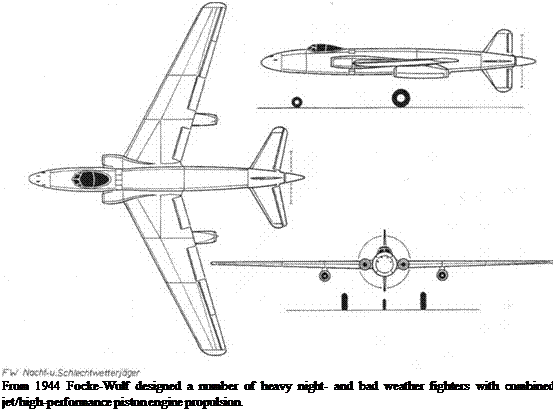Heavy Fighters and Destroyers
A final attempt to realise an all-weather jet aircraft besides the Me 262 was made at the beginning of January 1945. Apart from the 1 TL aircraft already mentioned, of which many designs exist, for the first times guidelines were established for an equally powerful 2 TL fighter.
On 27 January Chief-TLR issued his first instruction for the planning of such an aircraft. By early February the decisive specification for the later development, worked out with members of the EH К Flugzeuge, were notified to individual manufacturers. The result was to be a heavy fighter and destroyer armed with at least four, or if possible six MK 108s, and 160 rounds per gun. The fixed, forwardfacing weapons were to be housed in a sealed turret. In place of the MK 108, the installation of up to six MG 213s was considered, of which four would have been located in the turret, but this was reduced to two to save weight. Two 30 mm MK 108s were planned as upward-firing weapons. This powerful armament was to be supplemented by a trainable gun firing to the rear. All machine guns had extremely efficient automatic aiming devices. This was extremely important because OKL proposed to deploy the heavy fighter, and the fighter-bomber version, in all weathers and at night. The installation of two HeS Oil A-ls or TLR engines would make the machine into a long-distance fighter with a fast rate of climb.
The turbine-rocket combination would climb steeply to the ceiling of 10,000 metres (33,000 ft) with good endurance at that altitude. Propulsion and an offensive radar system with automatic solution finding were to be situated forward and a target-finder in the rear was to be used to detect attacking enemy aircraft. The most important elements were to be well armoured and resistant to 20-mm hits; 4,500 litres (1,200 Imp gal) of fuel was to be carried. Wing loading worked out at 300 kg/sq. metre (7,100 lb/sq. ft). Speed was to be at least 1,000 km/hr (620 mph), adequate for engaging all known enemy aircraft.
Focke-Wulf, especially from 1944 onward, developed numerous studies for a two-seat heavy fighter with up to three turbines. Starting from the ‘two- propulsion system TL fighter with the HeS Oil’of 23 November 1944, various studies were completed by the end of the year. Their aim was an all-weather night fighter with two HeS 011 turbines. At the conclusion Focke-Wulf could put forward five different designs, the last being completed on 19 March 1945. The almost 20-tonne aircraft with three HeS 011 turbines could operate at 14,000 metres at a top speed of 900 km/hr (46,000 ft; 560 mph).
Dornier had also given thought to a multi-engined heavy all-weather fighter with mixed plant such as As 413 with Jumo 222 C and D, or two DB 603N and two BMW 003. This kind of thinking was too cosdy to build having regard to the war situation, and for this reason Dornier went over to a three-seater operational aircraft with two HeS Oils. Even then, none of the designs was possible at that time. Nevertheless EH К was still duty-bound – with the greatest optimism – to announce that it would soon be possible to turn out 100 2 TL fighters monthly. On 9 March 1945 OKL completed its previous specifications for the 2 TL project, now known by its final designation ‘2 TL All-Weather and Night Fighter’. Besides improved oblique armament the

machine would have a tactical brake (a special flap designed to reduce flight speed rapidly) from the start. On 2 April the equipment for the later operational aircraft was debated at Bad Eilsen. Although nobody knew where the next tank of fuel would be coming from, EH К was now considering even more complicated additions such as blind-firing processes and other advanced electronics for the concept. Discussions included a four-turbine long-range bomber to replace the Ju 287.
On 12 April 1945 all work on the new fighter was given up. There had been no possibility of the project being realised; the only result was to offer the victorious powers plenty of opportunity to catch up to the level of development achieved by the German aircraft industry.










